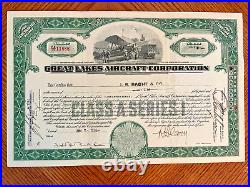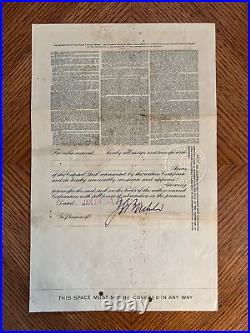


Great Lakes Aircraft stock certificate. Beautiful unique vignette of an early bi-plane being loaded with boxes at an airport with a plane flying overhead. Lucky serial number 11888. There is a whole website devoted to this company at. The company has a long history of building both private and military aircraft. Origins[edit] In 1929, the Great Lakes Aircraft Company (GLAC) was formed in Cleveland, Ohio at the former site of the Martin Aircraft Company. They built civilian biplanes, float planes, as well as biplane torpedo bombers and dive bombers under contract to the US Navy. In 1933 the Company was reportedly working on a steam power plant for driving aircraft turbines. [1] Great Lakes Trophy[edit] The Great Lakes Trophy was awarded in 1930 and 1931 to the fastest plane with an engine of 510 cubic inches or less that participated in the National Air Tour. [2] 2T biplane[edit] The model that most people think of today when someone says, “Great Lakes aircraft, ” is the enduring 2T biplane; also known as the Great Lakes Sport Trainer. The first engines were an 85 hp (63 kW) American Cirrus III. The 2T biplane was not as large as some of its contemporaries manufactured by Stearman, WACO and Travel Air. The original models had a wing span of 26 feet 8 inches and length of 20 feet 4 inches. The useful load was 578 pounds (262 kg) and it was stressed for 9 g positive and 6 G negative. It had outrigger landing gear with spring oleo shock struts, and the range was 375 miles. The first four Sport Trainers built were of a rare straight-wing design, one of which was modified into a special racer. Because of problems recovering from flat spins, the top wing was swept back and that is what most people recognize first when looking at a Sport Trainer. At its peak, Great Lakes had as many as 650 deposits for new aircraft. With the onset of the great depression, the Great Lakes Aircraft Company went out of business closing their doors in 1936. The company built just 264 of the Sport Trainers ordered. Smith of Willoughby, Ohio. [5] Aerobatic planes[edit] As the years went by, the original Cirrus engine installation was replaced by Warner radials, inline Menascos or Fairchild-Rangers, and horizontally-opposed Lycomings, Franklins, or Continentals. Tex Rankin, a stunt pilot of the 1930s and 1940s, made the Great Lakes Sport Trainer famous. He had one specially modified and installed a 150 hp supercharged Menasco engine. [6] It was painted red, white and blue with his name upright on one side, and upside down in the other, so folks would know who he was when he flew by upside down. Tex’s airplane is being restored by the Oregon Aviation Museum. For about 30 years, until the late 1960s, the Great Lakes Sport Trainer was the top American-made acro plane. Other pilots who made the Great Lakes reputation famous were: Hal Krier, Hank Kennedy, Bob “Tiger” Nance, Lindsay Parsons, Dorothy Hester, Betty Skelton, Charley Hillard, and Frank Price. The first United States entry in a world aerobatics contest was a Great Lakes biplane that Frank Price of Texas took to Eastern Europe in 1960.

